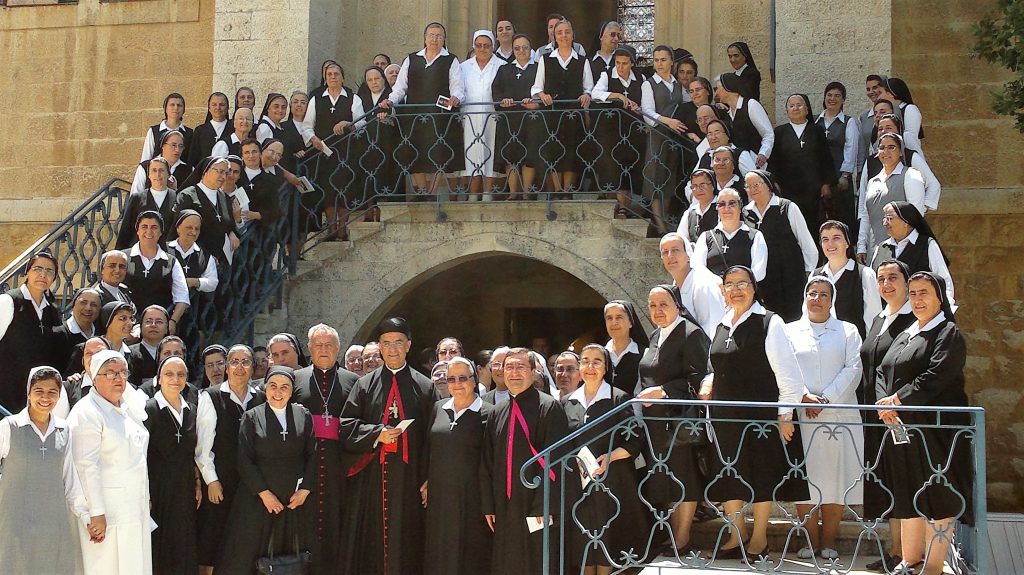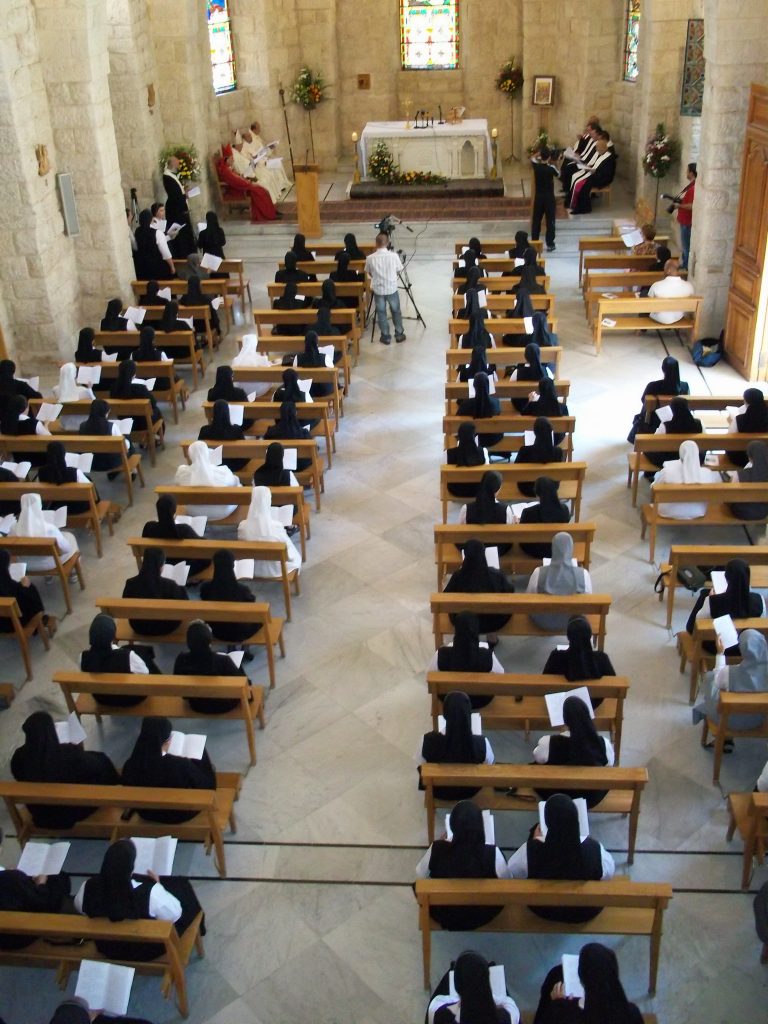The Story (so far) of the Congregation of the Maronite Sisters of the Holy Family (MSHF)
Dr Margaret Ghosn mshf

The Vision and Charism
Patriarch Elias Howayek, born in Lebanon (1843-1931), was unwavering in his conviction that the future of Lebanon relied on the education of young women, as they were the mother to be, the heart of the family, which in turn was the foundation of society. Through an education, they would become positive contributors in shaping the values of society. Therefore, he wanted to give the youth an education based on human, social and evangelical values.
So historically, the Congregation of the Maronite Sisters of the Holy Family (MSHF) was ‘founded for’ the ministry of educating village girls and was the first female institution to be founded in the Maronite Church and the Oriental Churches.
The Foundresses – Rosalie Nasr (1895-1899)
In 1893 a providential encounter between Sr Rosalie Nasr and Fr Elias Howayek would lead to the establishment of a new Congregation of Sisters. The Patriarch-Founder saw in her the calibre of an ideal founder.
Elias Howayek put at the disposal of Sr Rosalie Nasr and Sr Stéphanie Kardouche, a convent in Jbeil. It was the first ‘home’ and Mother Rosalie received its keys on 12 August 1895. On 15 August 1895, the first Foundation Mass was held. Since then, the Feast of the Assumption has become the Congregation’s Foundation Day.
Towards a new destination
In 1896, with the approval of Elias Howayek, Mother Rosalie purchased cellars that needed restoration at Ebrine, in the District of Batroun. This was to become known as the Convent of the Holy Family. She moved there in September 1896, one month after the foundation date.
The Founder gave the young Congregation the name of ‘Holy Family’, convinced that it would encourage the Sisters to follow the virtuous example of the Holy Family of Nazareth.
The initial purpose in establishing the Congregation was:
- Education of young girls and fulfilling the needs according to the time
- To respond to cries for Christian mercy in hospitals, orphanages, nursing homes and clinics, along with other humanitarian services.
- Catechesis classes and proclaiming the word of salvation, along with parish work in collaboration with the parish priest.
Just four years into the hard labour of establishing the Congregation, Mother Rosalie Nasr was stabbed in the heart by a girl who was asked to leave the novitiate. Half an hour later, Mother Rosalie passed away. She was martyred the night of 22-23 August 1899. She was of the age of 59.
There were many who thought this would be a fatal blow to the young Congregation. Yet the Foundress’ martyrdom served to strengthen it. The Founder Howayek revived the young Congregation after the distressing ordeal, with the words:
“The Congregation is a divine project, not a human one, it is founded on the divine providence, it shall persist as long as God wishes so”, “it is the field he cultivates and the edifice he constructs. It is He who made it prosper and He who preserved it… He shall preserve and bless it… this task is incumbent upon Him…”
The Co-Foundress – Mother Stéphanie Kardouche (1899-1927)
On 30 August 1899, one week after Mother Rosalie’s death, Stéphanie Kardouche took over as Congregational Leader and remained so for the duration of 28 years.
The objective of Mother Stéphanie was to build the Motherhouse. The decision was taken at once, with the new construction built over the blood of the Founding Martyr. Mother Stéphanie built a school as well as a boarding school. The nascent Congregation developed and expanded with astonishing rapidity.
During her succeeding terms, Mother Stéphanie founded fifteen houses and schools, and welcomed ninety-seven postulants. With the unshakeable faith and iron will of its cofounder, the young Congregation developed and expanded with astonishing rapidity. Stephanie’s double motto was ‘God and my Congregation’ and ‘Strongly backed by You Lord, I will never fail.’
Co-Foundress Josephine Howayek (1927-1961)
In 1900 Josephine Howayek entered the convent and became Congregational Leader in 1927, remaining in this role for thirty-four years. She founded seventy-three institutions when the Congregation had not yet reached its seventh decade. She established eight in Syria – between hospitals and schools. She focused on the religious and academic education of the Sisters, fostered arts and music.
Mother Josephine orchestrated the return of the Body of the Founder Elias Howayek from Bkerké to the crypt of the Mother House at Ebrine on 8 May 1936.
She died on 6th February 1964. Among her famous sayings include: ‘God’s generosity cannot be outdone’ and ‘Around us there is poverty. Who can help the poor but us. Give the poor what they seek, without distinction of faith.’
The Founding Sisters were outstanding exemplars of ministerial religious life, exercising their prophetic vocation of proclaiming the reign of God in challenging contexts. They were intelligent, practical, strong and virtuous. Towards the poor they were generous and compassionate. Their mission was constantly marked by trust in divine providence, fidelity to the Church, and a strong sense of justice.
Congregational Leaders
The reverend Sisters who fulfilled the important role of Congregational Leader in the Congregation of the MSHF are in order:
Rosalie Nasr 1895 to 1899
Stéphanie Kardoosh 1899 to 1927
Josephine Hwayek 1927 to 1961
Marthe Indaree 1961 to 1973
Marie Emile Nasr 1973 to 1991
Gilbert Fares 1991 to 1997
Verona Ziade 1997 to 2003
Gabrielle BouMoussa 2003 to 2014
Marie Antoinette Saade 2105 to 2021
Since the Foundation…
Moved by its faith and hope in Providence, the Congregation did not stop the foundational task. At each period, it drew its strength of pursuing its course, thus remembering the words of its Founder who tirelessly repeated with Paul, ‘I am confident of this, that the one who began a good work among you will bring it to completion by the day of Jesus Christ’ (Philippians 1:6).
The Spirit of the Congregation
The Congregation embraces much of what the recent Maronite Synod acknowledges as essential to the identity of the Maronite Church.[1] The Congregation is deep-rooted in the Antioch Syriac Maronite Church and aims to go deeper in its hermitic and apostolic spirituality. It is open to the universal Church, in an ecumenical spirit. It embraces its mission, perceives the needs of the Lebanese and Expansion, while serving all in the Body of Christ.

The Congregation of the Maronite Sisters of the Holy Family is a Religious Missionary Congregation of the Maronite Patriarchal Rite. It was founded ‘for the glory of God and the salvation of souls,’ and for service to the Church and the betterment of society.
In addition to prayer and personal sanctification the Sisters pronounce simple vows of chastity, poverty and obedience. It is through these vows the Sisters aim to a life of ‘lasting union with God’ through prayer and work, prophetic vision and charism.
‘It was God’s desire to found the Congregation of the Maronite Sisters of the Holy Family to educate God’s people on the basis of virtues which build homes…and protect families … and preserve societies from corruption…’
(Letter of the Founder Patriarch Elias Howayek 1915)
Situated in a country that expresses boldly a pluralism of faiths, the Congregation from the very beginning made, ‘no distinction between creeds and nationalities.’[2] It was focused on the needs of the times, committed to educational, humanitarian and spiritual services.
- In pedagogical and educational service – to all Lebanese children, in particular those of the mountain region, by establishing new schools, focusing ‘on religious precepts and principles of virtue.’
- In humanitarian and social services – establishing nursing homes, hostels, hospitals, orphanages and medical dispensaries. A response to the call to show mercy and undertake works of humanity without distinction between people.
- In pastoral service and Christian education – spreading the Word of God through catechesis and through missionary and pastoral services in local parishes alongside the priests.
- Through pastoral care of the family – the family unit was seen as the building block of society and the Church.
The ministry of the Religious Sister is to mediate the good news of God’s compassion and justice to people in concrete conditions. In serving, the Sisters display joy and confidence, the capacity for work and suffering, the commitment to their spirituality and to others.
Under the protection of the Holy Family, the Sisters live the spirituality of filiation, an act of faith in the love of the Father, revealed through blessings, providence and pleasure.
- In response to the love of the Father, we live the filiation in ongoing thanksgiving, in abandonment to God and in total resignation to God’s will as ‘a living sacrifice, holy acceptable to God,’ like the Son, in the Holy Spirit.
- Since ‘one of the requirements of love is to imitate the beloved’, we incorporate this filiation by a sisterly love in the community and in the apostolate, ‘for Jesus, with him and close to him.’
The goal is to reach a life of constant union with God to the glory of the Almighty and the service of all people according to the spirit of the Beatitudes, working for the Kingdom of God.
The Ministry – Educational Institutions
In the large cities of Lebanon, during the early 1990s, foreign schools were established. In the villages and mountainous regions, circumstances were more difficult. With the neglect of education of these children, the Maronite Sisters of the Holy Family began there. Today the Congregation counts approximately 40 institutions and educate thousands of students. Current institutions of the MSHF include:
In Lebanon
Education: Primary, K-10 and K-12 schools
Tertiary Education
Orphanages
Health
Hospitality
Aged Care in Lebanon
Parish ministry
Ministry in Australia
K-12 schools, Pre-school, Childcare and Aged care
Parish Ministry
Ministry in Syria and in Orange, California USA
Parish Ministry
Other ministries
The MSHF experienced the call over and again, to expand their vision. Ministry that developed alongside education and health included:
- Addressing factors including poverty, discrimination and special needs
- Addiction and violence assistance
- Accommodation for women
- Bible studies
- Caritas
- Catholic Media involvement
- Family ministry
- Hospitality
- Houses of prayer
- Mass assistance – weddings, baptisms and funerals
- Parish ministry and pastoral care
- Participation in Ecclesial Synods and Plenary Councils
- Publications in Parish newsletters, academic journals and books
- Retreats and Reflection Days and Spiritual accompaniment
- Students’ halls of residence
- Tertiary appointments
- Youth ministry
The MSHF experienced the call to expand their vision over time reflecting Vita Consecrata’s invitation to ‘the enterprising initiative, creativity and holiness of their founders and foundresses in response to the signs of the times emerging in today’s world.’[3]
[1] Patriarchal Maronite Synod, ‘Identity, Vocation and Mission of the Maronite Church,’ Text 2, 2006: paragraph 5. The Maronite Synod (2003-2006) distinguished aspects of the Maronite Church as an Antiochene Syriac Church, with a special liturgical heritage; secondly, a Chalcedonian Church; thirdly, a Patriarchal Church with an ascetic and a monastic aspect; fourthly, a Church in full union with the Apostolic Roman See; fifthly, a Church incarnated in her Lebanese and Eastern environment, and the Countries of Expansion.
[2] Patriarch Elias Howayek, Letter 2, paragraph 2.
[3] The Holy Father John Paul II Vita Consecrata , 1996 No 37. http://w2.vatican.va/content/john-paul-ii/en/apost_exhortations/documents/hf_jp-ii_exh_25031996_vita-consecrata.html